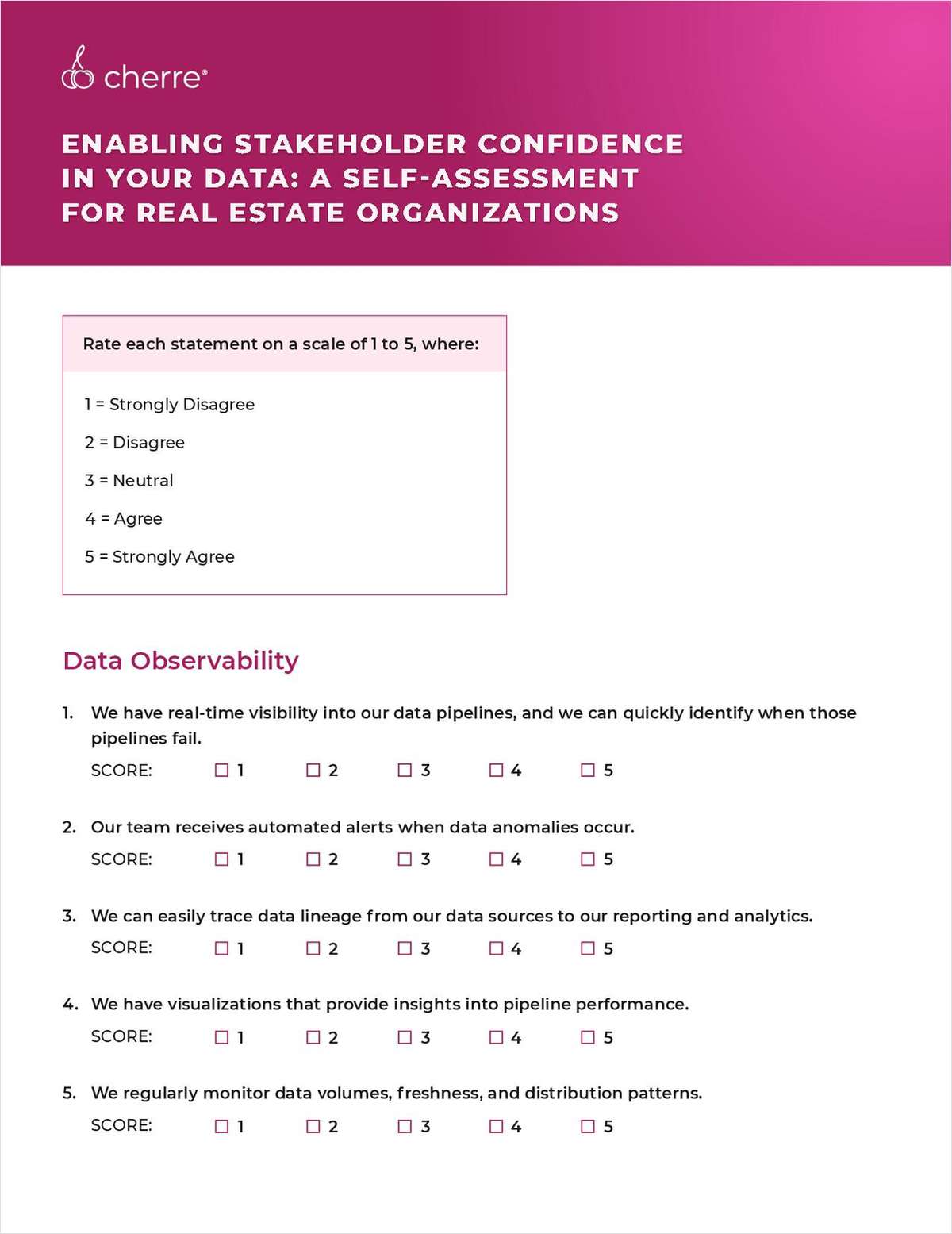IRVINE, CA—Despite slow recovery, modest vacancy improvement and tepid rent growth, office prices are robust, Ten-X's chief economist Peter Muoio tells GlobeSt.com. As we recently reported, the firm's August Office CRE Nowcast posted the strongest gain for the third consecutive month, rising 5.8% from July and 13.3% above its year-ago level, which is oddly juxtaposed against still-tepid fundamentals including vacancy rates. We spoke exclusively with Muoio about the factors causing this juxtaposition and what could potentially derail the office sector.
GlobeSt.com: How do you account for the juxtaposition of office pricing and office fundamentals?
Muoio: There are a few things going on here, I believe. First of all, the current strong increases in the office Nowcast come after several decidedly weak months early this year. As a result, office pricing is back on track with where it had been prior to the early year swoon.
But that said, there are other dynamics going on with office fundamentals and pricing that make it seem somewhat inconsistent. First, the macro office picture of slow recovery, modest vacancy improvement and tepid rent growth masks a significant subsurface dynamic where there are markets that are quite robust and others that are very weak, with little recovery if any from the downturn. As a result, pricing is bifurcated, with the strong run ups in the healthy markets (including New York, San Francisco, San Jose and Seattle) driving the reported price gains. Additionally, there is a strong divide between CBD and suburban office property prices and deal volume. Employers want to be where the talented workers are, so we see shifts like McDonald's moving its headquarters from suburban Chicago to downtown Chicago. Cadillac also moved its marketing team to New York City, and GE ditched Connecticut for Boston. Finally, overall investor interest in commercial real estate has been lifting the pricing tide, especially in this low-interest-rate environment.
GlobeSt.com: What makes office assets so attractive to investors?
Muoio: Another aspect making office assets in key US gateway cities attractive is their relative liquidity and store of value for foreign investors in uncertain times. This store of value is particularly important with global interest rates so low. Trophy or major-metro office assets provide this store of value, while still yielding higher than many other products and having a greater chance for price appreciation. However, foreign investor flows may slow in the wake of a stronger dollar following the Brexit vote and the new currency discount on London assets.
GlobeSt.com: What could potentially derail investor interest in office assets?
Muoio: Obstacles could include:
• Tougher financing. CMBS volume is down and faces uncertainty as risk retention rules kick in later this year. Movements in CMBS can often also signal shifts by other lenders.
• Strong dollar impeding foreign purchases.
• Higher interest rates putting upward pressure on cap rates and downward pressure on prices, though cap rate spreads are relatively wide and provide some buffer to higher interest rates.
• Perceptions of cyclical economic weakness ahead.
• Actual economic weakness causing rising vacancies and denting rent growth.
• Build-up of development in some of the currently hot office markets.
GlobeSt.com: What else should our readers know about office pricing?
Muoio: US-level office-pricing statistics are really not representative for many markets. These statistics are being dominated by the large coastal markets that are experiencing robust local economies and foreign capital inflows as we discussed earlier. Smaller metros with robust local economies such as Atlanta, Austin, Nashville and Raleigh-Durham may offer additional cushion against the potential rise in interest rates, since their cap rates have not experienced the same compression due to the global capital flows and chase for yield, while still offering a robust backdrop for office fundamentals.
IRVINE, CA—Despite slow recovery, modest vacancy improvement and tepid rent growth, office prices are robust, Ten-X's chief economist Peter Muoio tells GlobeSt.com. As we recently reported, the firm's August Office CRE Nowcast posted the strongest gain for the third consecutive month, rising 5.8% from July and 13.3% above its year-ago level, which is oddly juxtaposed against still-tepid fundamentals including vacancy rates. We spoke exclusively with Muoio about the factors causing this juxtaposition and what could potentially derail the office sector.
GlobeSt.com: How do you account for the juxtaposition of office pricing and office fundamentals?
Muoio: There are a few things going on here, I believe. First of all, the current strong increases in the office Nowcast come after several decidedly weak months early this year. As a result, office pricing is back on track with where it had been prior to the early year swoon.
But that said, there are other dynamics going on with office fundamentals and pricing that make it seem somewhat inconsistent. First, the macro office picture of slow recovery, modest vacancy improvement and tepid rent growth masks a significant subsurface dynamic where there are markets that are quite robust and others that are very weak, with little recovery if any from the downturn. As a result, pricing is bifurcated, with the strong run ups in the healthy markets (including
GlobeSt.com: What makes office assets so attractive to investors?
Muoio: Another aspect making office assets in key US gateway cities attractive is their relative liquidity and store of value for foreign investors in uncertain times. This store of value is particularly important with global interest rates so low. Trophy or major-metro office assets provide this store of value, while still yielding higher than many other products and having a greater chance for price appreciation. However, foreign investor flows may slow in the wake of a stronger dollar following the Brexit vote and the new currency discount on London assets.
GlobeSt.com: What could potentially derail investor interest in office assets?
Muoio: Obstacles could include:
• Tougher financing. CMBS volume is down and faces uncertainty as risk retention rules kick in later this year. Movements in CMBS can often also signal shifts by other lenders.
• Strong dollar impeding foreign purchases.
• Higher interest rates putting upward pressure on cap rates and downward pressure on prices, though cap rate spreads are relatively wide and provide some buffer to higher interest rates.
• Perceptions of cyclical economic weakness ahead.
• Actual economic weakness causing rising vacancies and denting rent growth.
• Build-up of development in some of the currently hot office markets.
GlobeSt.com: What else should our readers know about office pricing?
Muoio: US-level office-pricing statistics are really not representative for many markets. These statistics are being dominated by the large coastal markets that are experiencing robust local economies and foreign capital inflows as we discussed earlier. Smaller metros with robust local economies such as Atlanta, Austin, Nashville and Raleigh-Durham may offer additional cushion against the potential rise in interest rates, since their cap rates have not experienced the same compression due to the global capital flows and chase for yield, while still offering a robust backdrop for office fundamentals.
Want to continue reading?
Become a Free ALM Digital Reader.
Once you are an ALM Digital Member, you’ll receive:
- Breaking commercial real estate news and analysis, on-site and via our newsletters and custom alerts
- Educational webcasts, white papers, and ebooks from industry thought leaders
- Critical coverage of the property casualty insurance and financial advisory markets on our other ALM sites, PropertyCasualty360 and ThinkAdvisor
Already have an account? Sign In Now
*May exclude premium content© 2024 ALM Global, LLC, All Rights Reserved. Request academic re-use from www.copyright.com. All other uses, submit a request to [email protected]. For more information visit Asset & Logo Licensing.








